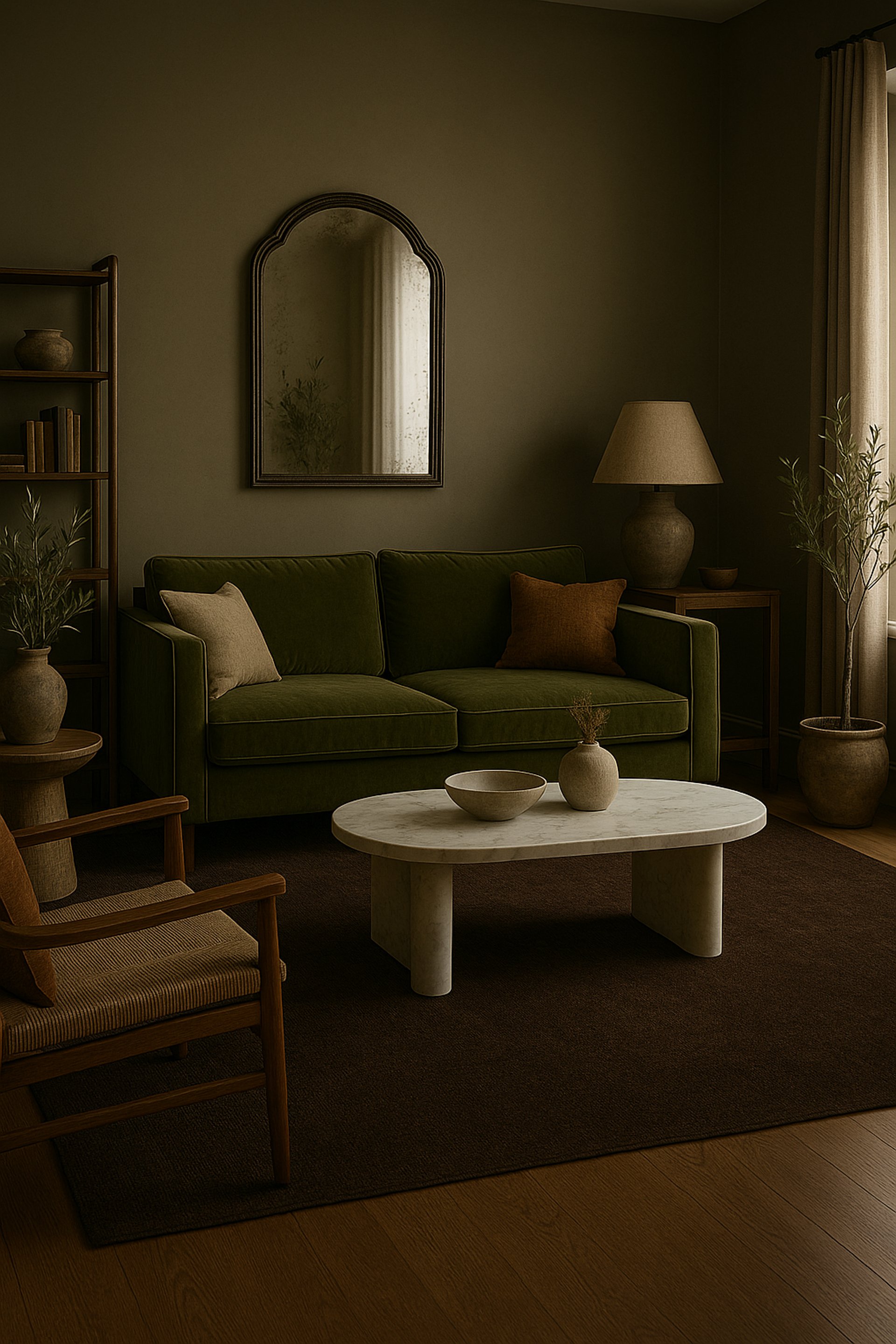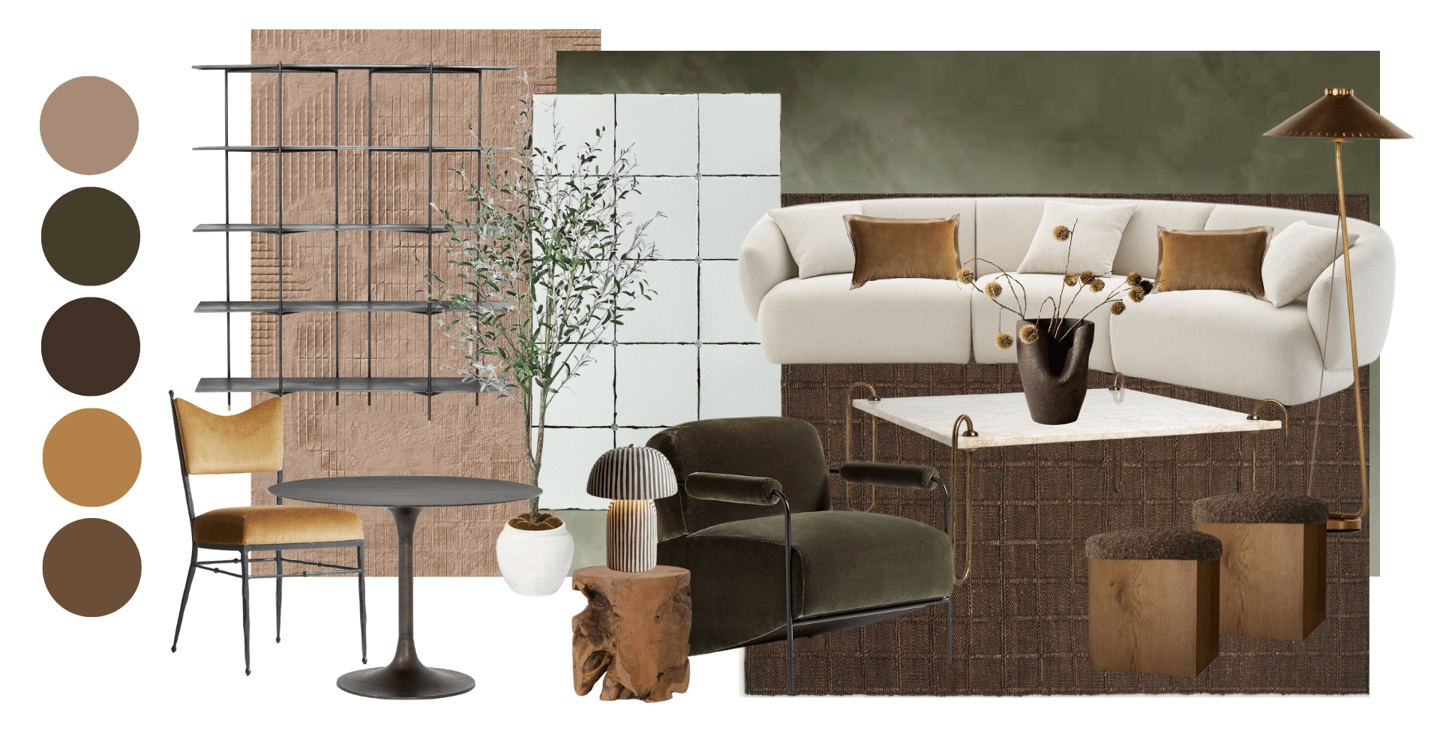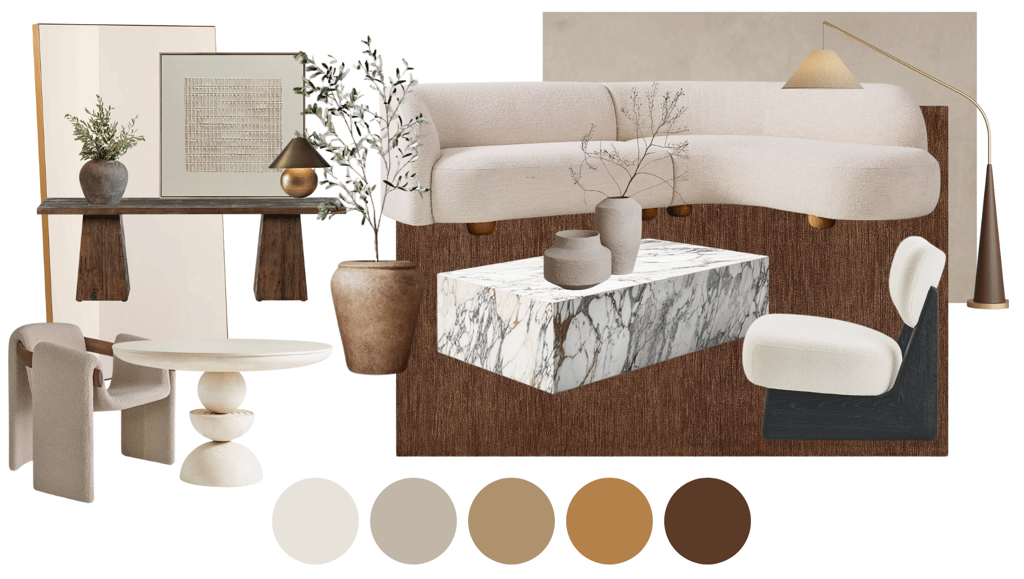
Designing with Intention: A Moody Organic Living Room Mood Board
Discover how to create deeply calming, elevated spaces with moody organic interiors. From rich earthy palettes to a blend of vintage and modern textures, this guide breaks down how to bring warmth, depth, and natural elegance into your home—starting with a curated mood board and real, shoppable pieces.
HOME DECOR


The Essence of Moody Organic Design
Moody organic design encapsulates a unique blend of aesthetics that prioritize comfort and sophistication in living spaces. At its core, this design philosophy centers around the use of earthy textures and grounding colors that evoke a sense of tranquility. In contrast to more conventional and bright design approaches, moody organic design often embraces a palette of deep greens, rich browns, and muted grays, creating an atmosphere that feels both warm and enveloping.
One of the defining characteristics of moody organic interiors is the intentional mix of vintage and contemporary elements. This eclectic juxtaposition can introduce an appealing narrative to a space, allowing for storytelling through decor. Vintage furnishings, through their unique histories and distinct craftsmanship, can serve as focal points that anchor the room, while contemporary elements, such as modern lighting or artwork, infuse it with a sense of freshness and relevance. The interplay between these elements enhances the organic aesthetic, reinforcing the connection between past and present.
The careful consideration of materials further enriches the sensory experience of moody organic design. Handcrafted wooden pieces, soft linens, and natural stone add depth and texture, inviting touch and interaction. Additionally, incorporating plants can enhance this organic approach, bringing life and airiness into the living space. The presence of greenery not only connects the interior to nature but also contributes to improved well-being, a core tenet of organic living.
Utilizing mood boards is an effective strategy for capturing the essence of this design style. By visually organizing elements such as color swatches, textures, and decor items, a mood board serves as a guiding reference throughout the design process. It allows designers to hone in on the desired atmosphere and ensure that each component harmonizes with others, ultimately creating a space that feels beautifully grounded and inspiring.
Want This Look?
Some of the actual pieces used in this concept:
Color Palette Selection
When designing a moody organic living room, the choice of colors plays a critical role in establishing a visually cohesive and inviting space. The selected color palette features warm, earthy tones such as olive green and rich chocolate brown, both of which evoke feelings of comfort and tranquility. Each color in this palette serves a unique psychological purpose, enhancing the overall ambiance of the room. Olive green, with its natural and nurturing characteristics, symbolizes growth and renewal, creating a serene environment that promotes relaxation. Meanwhile, rich chocolate brown offers a grounding effect, enveloping the space in warmth and sophistication, which can be particularly inviting during social gatherings or quiet evenings.
To enhance the moody organics theme, it is essential to thoughtfully select complementary colors. Neutral shades like beige or cream can provide a soft contrast, allowing the deeper hues of olive green and chocolate brown to stand out without overwhelming the senses. Incorporating accents in muted gold or deep rust can further enrich the palette, adding depth and vibrancy. When incorporating these colors in interior design, balance is key to maintaining harmony. For instance, using olive green for larger furniture pieces, such as a sofa or armchair, draws attention without dominating the space. In contrast, chocolate brown can be effectively utilized in accessories like cushions or throws, providing layered texture and comfort.
When implementing a color palette, consider the different light conditions of the room throughout the day. Natural light can enhance the earthy tones, while artificial lighting can give them a different character. Experimenting with various finishes—such as matte versus glossy—can also affect how colors interact with one another. Ultimately, creating a moody organic living room requires a thoughtful approach to color selection and application, ensuring a harmonious and inviting environment.
Textures and Materials: Layering for Depth
When designing a moody organic living room, the careful selection and layering of textures and materials are essential to create a cohesive and inviting space. Textures serve not only as tactile elements but also as visual components that significantly enhance the overall ambiance. Essential materials to incorporate include velvet, wood, and natural fibers, which work harmoniously together to evoke a sense of warmth and comfort.
Velvet is a luxurious fabric that adds depth to your living room. Its rich texture reflects light in intriguing ways, contributing to a moody and sophisticated environment. Consider using velvet for upholstery on sofas or accent chairs, providing a sensual touch that invites relaxation. Pairing velvet with more rugged materials, such as distressed wood, creates an elegant contrast that enhances visual interest. Wood brings an organic quality that grounds the space; options like reclaimed or dark-stained woods resonate with the earthy vibe typical in moody aesthetics.
Natural fibers are another crucial aspect of layering textures. Incorporating items made from materials such as jute, cotton, or linen fosters a sense of connection to nature, essential in achieving that organic look. For instance, a jute rug can serve as an excellent foundation for the seating arrangement, while linen throw pillows can complement velvet upholstery and add softness. The juxtaposition of different textures creates layers of depth, allowing for various interactions that engage the senses.
Incorporating these materials throughout your living room can be seamlessly achieved through decor choices such as drapery, area rugs, and decorative accents. Choosing natural palettes that reflect the outdoors, such as muted greens, earthy browns, and soft greys, will further enhance the mood. Thus, focusing on a thoughtful combination of textures and materials can amplify the organic essence of your living space, resulting in a soothing and visually striking atmosphere.
Want This Look?
Some of the actual pieces used in this concept:
Mixing Vintage and Contemporary Elements
Integrating vintage and contemporary elements within a living room creates a unique atmosphere that reflects personal style and storytelling. The intentional blending of these two design aesthetics fosters an inviting space while allowing for creative expression through diverse influences. To achieve harmony in your living room, begin by selecting key vintage pieces that resonate with you. These could be family heirlooms, thrift store finds, or even antique store treasures. The charm of vintage decor often lies in its history, which adds character to the otherwise sleek lines of contemporary design.
When pairing vintage items with modern furniture, consider color palettes and textures. Choose contemporary pieces that complement the colors present in the vintage items to unify the overall design. For example, a classic leather armchair might pair beautifully with a sleek, modern coffee table, creating an eye-catching focal point. The juxtaposition of materials, such as wood, metal, and fabric, can also enhance the room's aesthetic by offering tactile variety and visual intrigue.
Another key strategy lies in the careful placement of each item. Balancing the scale and proportion of vintage and contemporary pieces will ensure that neither overwhelms the other. Placing oversized vintage art on a minimalist wall can create stunning contrast without causing visual clutter. Additionally, creating groupings of various elements, such as a vintage lamp accompanied by modern sculpture, can help establish a cohesive narrative within the space.
Ultimately, the goal is to curate a living room environment that reflects both past and present influences while fostering a sense of continuity. Each carefully selected item should contribute to the mood of the room, embracing the charm of vintage finds while celebrating the innovation of contemporary design.


